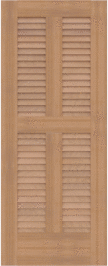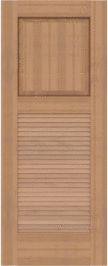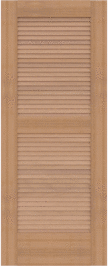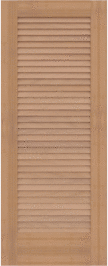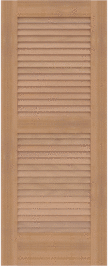Finish Them! Practical Tips for Finishing Your Doors and Shutters
Published: May 15, 2020
At the end of your woodworking project you will be dealing with the issue of how to protect and preserve the woodwork you've spent all this time on. This is no small matter. Now that you have invested time and money into your project, you quite naturally want it to last a long time and look good doing it. This final phase of a woodworking project, and the stuff you put on your woodwork, is called finishing.
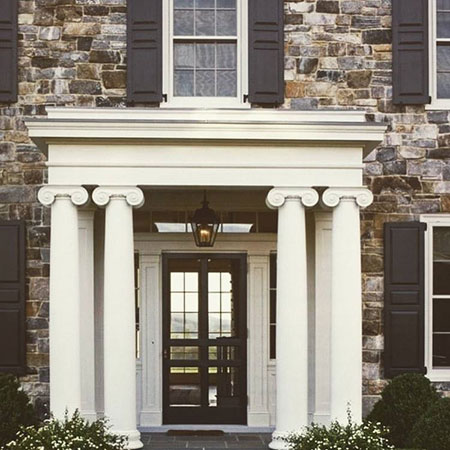
Now before we go too far, we should clarify the difference between painting and finishing. They are not the same. This might seem obvious, but it should be said. For doors and shutters, especially those that are going to spend time outdoors, painting is your best bet for durability and protection. A painted piece of woodwork does not need to be finished. Paint is the Finish! Paint is the final coat that protects and seals the wood.
If you did your painting correctly, you can not see the wood under all that paint. That's obvious, of course, but here is where finish comes in. A good finish protects and seals the wood from external threats (moisture, sunlight, family members who like to throw liquids around, etc.), like paint does. The big difference is that a finish will let you see the wood underneath with its warm color and beautiful grain. In most cases, a finish will even help make that wood look better. So, as a very general rule, for outdoor use, paint. For indoor use, finish. A lot of woodwork these days you want to keep inside and use anyway (like a door, for example), so finishing is often the choice, and a very good choice too.
Finishing is also one of those big topics in woodworking that always gets folks talking. A good, genuine question for someone who does not know a lot about woodworking, but does want to learn about it (or just look like they do), is to ask a woodworker about a project of theirs and add, "What did you finish it with?" The answer will probably go into the ‘why' of their choice without much prompting from you. Its a big, interesting question in the woodworking world. Its a bit like asking someone who likes to fish, "What kind of fishing lure do you use?" If the person is passionate about fishing, you should get a long answer about specific lures for specific fish. It's that kind of question.
The reason for the great debate over finish is the simple fact that there have been many finishes developed over the years. People have been woodworking for centuries, and they have developed answers to the great question of finishing using the technology and knowledge of their time. Some of those old Finishes are still valid options today, especially if you are doing restoration work. Shellac is probably one of the oldest finishes, but there are many others. There are a lot of oil finishes out there, for example, and lacquer can be very impressive if worked with an experienced hand. Polyurethane is a more modern development that can provide very, very durable results, and if all else fails you can give your woodwork a quick, temporary finish with wax.There are even blends of all of the above available! The choices are many, and can be confusing.
So to be more practical about it, the best thing we can recommend is to use a finish that is recommended by the manufacturer of whatever other product you have been using on your woodwork already. If you have been using a stain on your doors or shutters, for example, its a good bet that the maker of that stain has some kind of finish formulated to work with that stain. In the world of stains, for example, it's not unusual to see a stain and finish both combined in the same product. Companies these days invest a lot of time and effort to get these combinations right.
The woodworking community is very passionate about their projects, and woodworkers love to talk to each other about them. So if a company does a bad job of a finish, folks will raise a fuss about it. After all, a woodworker can spend many, many hours working on a piece. If a badly made finish ruins it, there will be angry voices complaining about it! Count on that. So to decide on a finish, see what your favorite woodworking supply manufacturer recommends, and then ask a woodworker or two about it (or search out a Forum and see what is said there about that product).
That said, there are some general rules. For example, we'd recommend you use a polyurethane finish on your woodwork, especially doors and shutters for indoor use. Polyurethane is a tough resin varnish that protects wood very well. It can even work well for outdoor use. Most deck work uses it, for example. Polyurethane, or a polyurethane blend, comes in a lot of varieties and combinations, in a wide range of products. Professionals that are set up to work with polyurethane a lot usually have serious equipment for its use, including sprayers, protective clothing, and industrial strength ventilation.
For the normal woodworker, a water or oil based polyurethane blend will do just fine. Choose the variety that uses a brush for application, as that will make the most sense when working with doors and shutters. Water-based blends tend to preserve the color of your wood, especially lighter woods, and they are usually safer to work with (but never neglect good ventilation when woodworking). They also dry more quickly than oil-based blends. On the flip side, an oil-based polyurethane blend will act as a stain to some degree, giving the wood a nice red-orange glow (the exact color depends on the blend), and highlighting the grain too. If you have skipped the stain step of woodworking, but want some detail in your woodwork, this is the choice for you.
As always, whatever product you choose to use for your finishing work, read the directions! They are there for a reason. It is also never a bad idea to practice using your Finish on a sample or scrap piece of wood. Do not forget your gloves, and never neglect proper ventilation!
If this article has piqued your interest in the complex world of finishes, then it is a job well done. This is just a basic overview though. Research a finish if you can, and practice with them. It is worth the time. Yes, painting is a skill, and we admit that Leonardo Da Vinci was pretty good at it, but in my humble opinion, it takes a true artist to lacquer! Once you get that done right, you can proudly say that you know how to finish a project.
Build your new Custom Louvered Doors and get a Free Instant Quote Today
Our state of the art designers allow you to design and build completely customized Louvered Doors to fit your exact needs.
Questions or concerns contact us here or via 412.641.0177 .
Build an Instant QuoteGet Started Designing Your New Wooden Shutters Today!
Check Out Our Line of Louvered Doors
Need Help?
Contact Us @ 412.641.0177
Recently Published
Interior Cabinet Door Styles That Elevate Your Kitchen Or Bathroom
Published: November 12, 2025
Why Mortise
Published: October 23, 2025
From Shaker To Raised Panel: Cabinet Door Styles That Transform Your Home
Published: October 08, 2025
How To Match Door
Published: September 30, 2025
Choosing The Right Exterior Shutters: Louvered, Board
Published: September 25, 2025
The Warmth Of Wood: Barn Doors Tailored To Your Home
Published: September 09, 2025
Classic Style, Modern Strength: Custom Wooden French Doors
Published: September 03, 2025
Built By Hand, Designed To Last: Custom Wood Louvered Doors
Published: July 07, 2025
Flat Panel Shutters For Colonial, Craftsman, And Farmhouse Styles
Published: May 28, 2025
Bring Old-World Charm Home With Custom Wooden Louvered Shutters
Published: May 04, 2025




